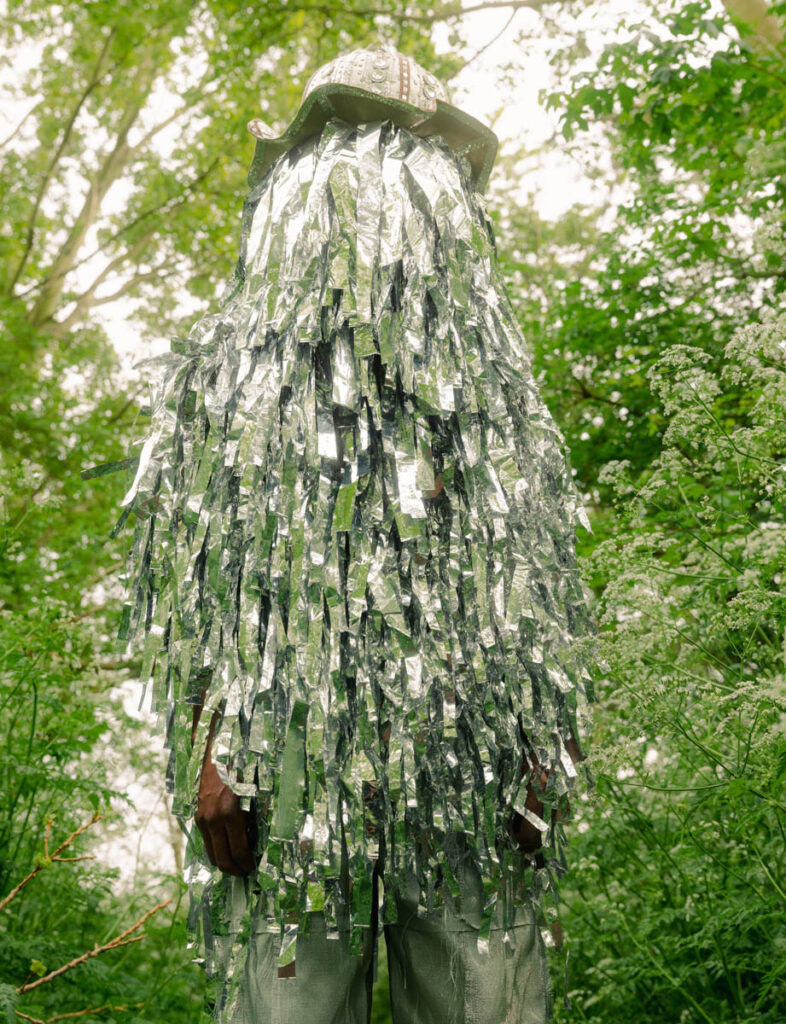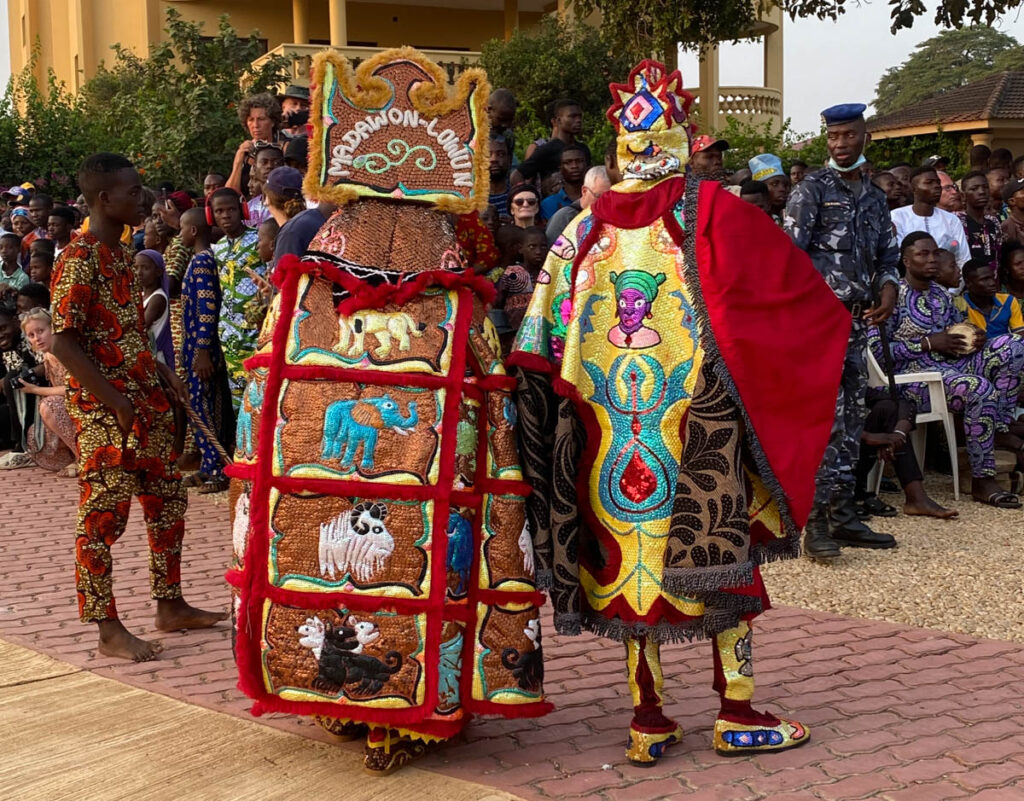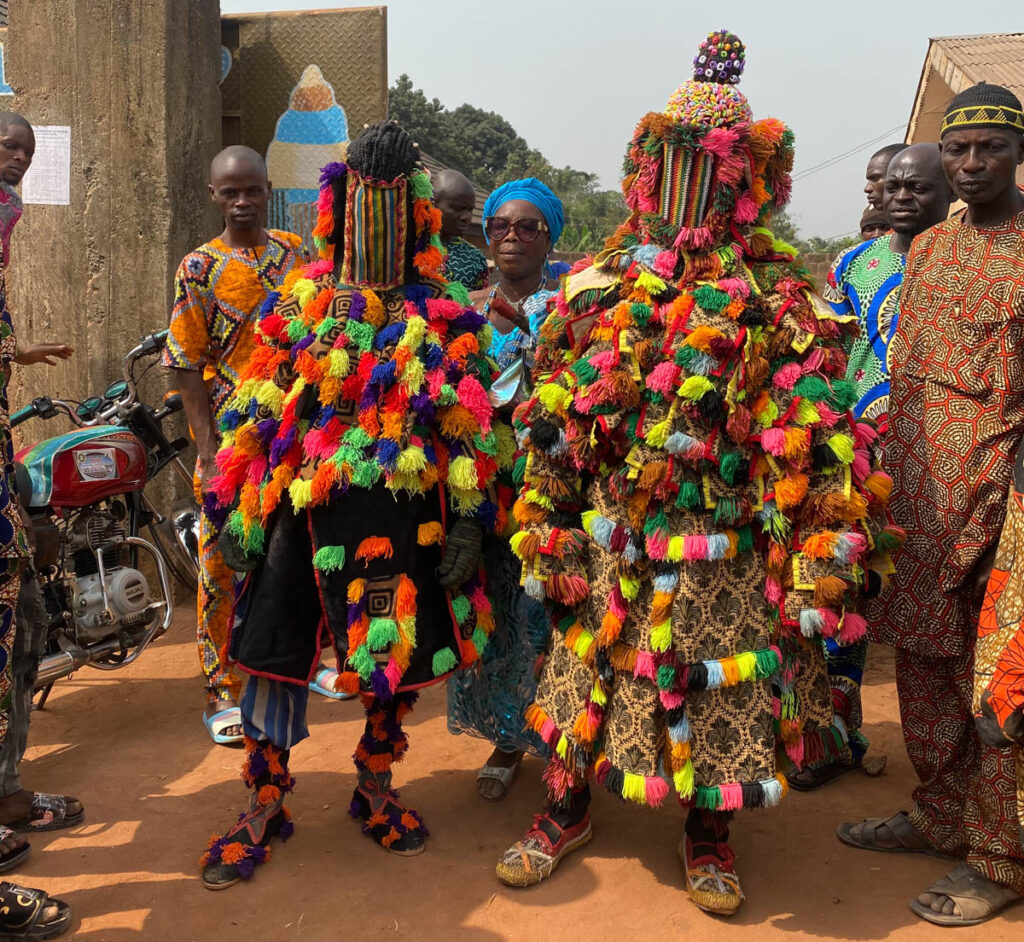Bubu Ogisi speaks about her masquerade costumes, which belong to spirits that can heal the disorder in the world. She locates these in an art gallery, which functions as a “sacred grove” for the spirits to come together.
Bubu Ogisi is a fibre artist and Creative Director of the contemporary art brand, IAMISIGO. Born in Lagos, Nigeria, and growing up between London, Lagos, Accra and Paris and now living between Dakar, Lagos and Nairobi, she studied Fashion at Ecole Superieure des Art et technique de la Mode (ESMOD) Paris, France. Her work reflects how the body exists and interacts with space through time, by creating wearable art pieces and installation art pieces with unconventional materials and ancient textiles techniques from all over the African continent. Her work aims to decolonise and free the mind by manipulating gravity, light, colour, mass, and transparency to demonstrate the infinite transformations and iterations of materiality. Her work features rawness, anti-“finishing” (and therefore anti-Eurocentrism) and functionality. By exaggerating texture, structure and space, her costumes speak to a transient humanity.
✿ What is unique about your fashion brand?
Our work primarily focuses on how fashion and textiles can not only keep history alive but also pass on information for the future through the preservation of techniques and expression through matter, thereby using the ultimate canvas, the human body, via clothing as a vehicle of communication. We create wearable art pieces with unconventional materials and heritage textiles traditions through in-depth research with remote African communities in different parts of the African continent. We convey lost historical stories and transform these found “data” and apply them to garments and fibres, as a form of silent protest to post and neo-colonialism, portrayed through textile art, space installations, visuals and film. Our work focuses on decolonizing the mind thoroughly, by questioning and engaging a variety of thoughts in relation to socio-political questions i.e. religion, gender, traditions, symbols and scripts, tribes and magic as well as questioning future issues such as our ecosystem. How do we embrace our histories as having passed and move forward?
All of my materials and techniques are original designs sourced and created in different parts of Africa putting into consideration the artisans we work with, how they work and where they work. The idea is to remove the construct of borders and to merge different ideas to create a unity in matter and space. As an agent of change, the ideology is to highlight and promote cultural crossover where no identity is negotiated, bringing together different multicultures to create free-minded pieces. Our work is 100% artisanal and handmade focusing on ancestral techniques, while incorporating waste and other unconventional fibres to create wearable artwork showing the importance of preserving handmade processes and upcycling to deal with our planet’s issues.
✿ How did you learn about the masquerade and what happens in it?
Growing up in Nigeria, masquerades are an integral part of our culture. As a female child, I would sneak out to watch masquerade festivals even though I was forbidden as a female or child to lay eyes on such a sacred ritual performance. I was still very much intrigued by the entities but more importantly by their attire.
There is abundant evidence that masquerades are elements of the most sacred institutions in many African cultures. The masquerade represents part of a larger cultural ethos, in understanding what is seen as terrifying, horrible, ugly and the devil’s grimaces, whose purpose is to ward off enemies and evil spirits.
Masks serve as an expression of complex symbolism, they are worn not only on the face but also on the temple walls, on the back of the head, on the upper arm, on the knee and even held in the hand laid on the floor. Many masquerades serve ritual purposes and are considered magically powerful objects.
According to traditions, the mask maker must create in a sacred space and must observe certain rules, like fasting, sexual abstinence, avoidance of death or dead bodies, and not take part in wearing the masks in dance or performance.
A considerable proportion of the masks originating in Africa are made for one or another of the numerous “secret” societies, these organizations are so diverse and complex in nature that no general description fits them. They are usually purely masculine, yet the exclusion of women is not strictly practiced everywhere.
The adjective “secret” refers to the jealously guarded knowledge of procedures and certain ritual objects, which are thought to contain supernatural powers.
✿ How do the costumes help the masquerade go well?
The making of masks is generally a creative artistic activity of imaginative unconventional models characterized by a dialectical interplay of tradition and innovation.
The themes and motifs employed in this body of work combine more or less recognizable human features with the textures of animal features. The morphological characteristics do not suffice themselves to emit definitions of styles or rather stylistic groupings. These emerge from a comparison of individual objects, which evince similarities close enough to justify speaking of a relative continuity of form or combination of forms. The sum of similarities can then define a stylistic grouping. Using the word style, even though it may be accurate, does not imply a chronological determination.
In reality, tribalism belongs to the phenomenon of colonialism, ethnic sensibilities in Africa are relative and ethnic identities shift and blur.
The embodiment of spirits within this family of masquerades relates to the fertility of crops, the end of the scourge, the warding of destructive spirits, and a restoration of the social order established by supernatural beings in times of immemorial, each mask is intended in principle to represent a certain spirit, The range of masks is furthered increased by the fact that each type is reserved for a single degree of rank: lower ranking masks to stronger higher ranking masks.
✿ How do your costumes compare to the ones traditionally made for the masquerade?
The art of mask-making is not simply to copy an existing model. The result is never to create a replica, let alone a faithful copy.
This body of work involves an effort of thinking, reflecting a concern with something that had not yet been realized which spurred me to creative expression. This all came from the spirits. There is at first only a vague idea of form, then lending material shape to the mental image with all the skill at my disposal.
The great majority of African masks are associated directly and indirectly with supernatural beings and spirits. The performance of masks is generally thought to represent the visit of spirits from the beyond among men in the here and now, in particular spirits of possession. The concepts of both spirits and masks are often inspired by dreams and visions. The artist to whom the supernatural presence reveals itself captures its image and the community accepts or rejects its representation in this form.
A mask provides no clear indication of the type of presence it is intended to visualize. A performer’s assumption of a mask and disguise can signify spiritual transfiguration, not only of the outward appearance of the masker but his very body and soul. The masker in his eyes and the eyes of the audience temporarily ceased being himself.
The spirit’s power is absolute. This power inheres solely in supernatural beings, the masquerade is ineffectual and without meaning outside the ritual.
I am a tool of supernatural forces, which guide my hands.
I am a tool of supernatural forces, which guide my hands.
Every piece is just a fragment of an imagination, a dream and a vision. For the artist’s depiction to become complete requires the viewer’s imagination.
✿ Do you have plans for these costumes beyond the exhibition?
Our ritual installation “I am not myself” is centered on our continuous ethos of borderless ideologies via decolonizing spaces. This presentation piece mirrors a “sacred grove” a secret space where masquerades are stored. Therefore the exhibition is a nomadic piece that will be moving from country to country. The next locations are the Benin Republic, in honour of the voodoo festival that happens every year in January, and the United Arab Emirates.
✿ What’s a common misunderstanding about your work?
The road from demoniacal curios to highly valued works of art was studded with misunderstanding. With this body of work in this space we aim to use aesthetical systems to change the incomprehensible eyes of the west to be seen as a carefully considered distillation of forms.
As an esteemed creator of identifiable bodies of work using past ancient techniques as well as new, we begin to disrupt the assumption of naïve spontaneity.
The suspenseful relationship between old and new is the key to understanding the history of art in general. Changing social and intellectual circumstances cannot help but produce changes in the forms and functions of masks. To this extent, the use of expression represents an acceptance and continuation of these traditions.
The revolution now underway in the arts in terms of both context and form remains genuinely an African revolution.
The spirit devours us and then coughs us out. In essence, the spirit’s mouth becomes a door to the future.
- Images from the voodoo festival in Benin Republique January 2023 and the Egungun festival in Ogun state February 2022
✿ Apart from the exhibition, will the pieces be used in an actual masquerade? Or does the traditional culture that supported the masquerade no longer exist, and has been replaced by the gallery?
Yes, the pieces are always activated with a performance as was the case with the Tetley Museum opening and with all my other body of works. All traditional cultures that support masquerade never die, they live on forever, the pieces being in a gallery serve as a once-in-a-lifetime portal of opportunity to view the installation that mirrors a sacred grove.
✿That for me is a critical question: what it means to have the masks in the gallery, rather than the sacred grove?
This work mirrors a sacred grove. This family of masks/masquerades (according to tradition) is to be kept in a special building, not to be shown or touched except on certain special occasions, regularly cared for. You have been granted rare access to this grove. This installation being a ritual piece “I am not myself” is centred on our continuous ethos of borderless ideologies via decolonizing spaces. By being in the gallery we are spiritually and physically decolonizing the space by injecting a piece that was formerly seen as demonic or not for public view to be brought to the forefront. We choose to disrupt the space with this piece of work.
The focus on urban spaces is also grounded in the fact that cities are becoming global actors to render it “preemptively anachronistic” as a consequence of a radical transformation of the stakes, forms and intensities of the decolonial struggle. Ultimately, however, we think that this new context has only further validated the importance and urgency of the work undertaken here. Not only is the connection between issues of contemporary racism and the colonial past which this work highlighted (based on religion and magic) here explicitly conceptualized, but also the various forms and content that the decolonial struggle can be invested with are revealed and examined.
Bubu Ogisi I am not myself was shown at Tetley Museum, Leeds 7 May – 29 August 2022. Works are also part of the 2023 Tel Aviv Biennale of Craft and Design.
About Bubu Ogisi
 Follow @bubuogisi
Follow @bubuogisi







